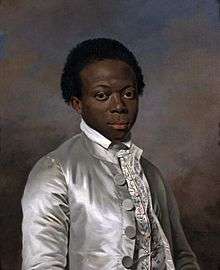Zamor
Zamor (christened Louis-Benoit) (1762[1] - February 7, 1820) was a French revolutionary of possibly Siddi Habshi origin from Bengal,[1][2] who, as a boy of eleven, was taken from Chittagong, Bengal Subah, Mughal Empire (now Bangladesh) by slave traders. Later, he was enslaved by Countess du Barry and became her servant until informing on her to the Committee of Public Safety. He participated in the French Revolution and was imprisoned by the Girondins.
Zamor | |
|---|---|
জামর | |
 Portrait of Zamor (1785) by Marie Victoire Lemoine | |
| Born | Louis-Benoit Zamor 1762? |
| Died | February 7, 1820 Paris, France |
| Resting place | Paris |
| Nationality | Bengal Subah (1762-1773), French (1774-1820) |
| Known for | French revolutionary |
| Home town | Chittagong |
| Movement | French revolution |
Early life and upbringing
Zamor was born in 1762[1] at the town of Chittagong in the state of Bengal (now Bangladesh). In 1773, when he was eleven years old, he was captured by British slave traders, who trafficked him into France via Madagascar and sold him to Louis XV of France. The King gave the young boy to his mistress, Countess du Barry, and he was christened Louis-Benoit. The Countess developed a liking for the boy and educated him.[3] Zamor developed a taste for literature and was inspired by the works of Rousseau. Till her death, the Countess was under the incorrect impression that Zamor was African (although Zamor may have belonged to the Siddi ethnic group, who descend from the Bantu peoples of East Africa).[1]
Records of the period suggest that Zamor was extremely mischievous as a child.[4] She noted in her memoirs:
The second object of my regard was Zamor, a young African boy, full of intelligence and mischief; simple and independent in his nature, yet wild as his country. Zamor fancied himself the equal of all he met, scarcely deigning to acknowledge the king himself as his superior.
Role in the French Revolution
When the French Revolution broke out, Zamor took the side of the revolutionaries and joined the Jacobins. He began to detest Countess du Barry and deplored her lavish lifestyle. He also protested her repeated visits to England with the intention of retrieving her lost jewellery and warned her against protecting aristocrats. As an informant to the Committee of Public Safety, Zamor got the police to arrest the Countess in 1792, on her return from one of her many visits to England. The Countess, however, secured her release from jail and found out that the arrest was the handiwork of her page. She promptly dismissed Zamor from her service. Infuriated, Zamor became more vocal and open in his support for the revolution. He brought further charges against the Countess, which eventually led to her arrest, trial and execution by guillotine. At the trial, Zamor gave Chittagong as his birthplace.
Imprisonment
Soon after the execution of the Countess, Zamor himself was arrested by the Girondins on suspicion of being an accomplice of the Countess and a Jacobin. He was tried and imprisoned, but was able to secure his release. He then fled from France, reappearing only in 1815 after the fall of Napoleon. Zamor bought a house in Rue Maître-Albert near the Latin Quarter of Paris and spent a few years as a schoolteacher.
Death
Zamor died in poverty on 7 February 1820[4] and was buried in Paris. His funeral reportedly had a very small attendance.
In popular culture
A two-page comic strip La Rue perdue (The Lost Street) was published in 1978, featuring Gil Jourdan, a detective created by Maurice Tillieux. Set in 1953, it has Jourdan trying to find out why a fake guillotine blade is hanging outside the door of a black African friend. The person responsible turns out to be a man obsessed with Madame du Barry and is taking his anger at her death out on Jourdan's friend, who looks like Zamor. The action is set in Rue Maître Albert, where Zamor lived before his death.
In Marie Antoinette, a 2006 film, Madame du Barry (portrayed by Asia Argento) was shown in company of a nameless black servant boy, who most likely is Zamor.
See also
- Reign of terror
References
- Gupta, Abhijit (March 11, 2008). "Child from Chittagong". The Telegraph.
- Sundarrajan, Saroja (January 18, 2003). "For liberty and fraternity". The Hindu:Young World.
Notes
- (in French) "Zamor (1762-1820)". une-autre-histoire.org. Une Autre Histoire. Retrieved April 10, 2017.
- "UNE AUTRE HISTOIRE".
- Weber, Caroline (2006). Queen of Fashion: What Marie Antoinette Wore to the Revolution. Macmillan. pp. 60. ISBN 0805079491.
- Lenotre, G.; Frederic Lees (1908). Romances of the French Revolution: From the French of G. Lenotre [pseud.] Brentano's. p. 135.
External links
| Wikimedia Commons has media related to Zamor. |